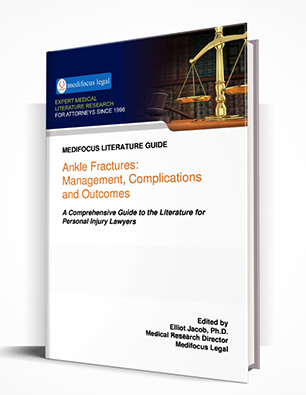Ankle Fractures: Management, Complications and OutcomesA Comprehensive Guide to the Literature for Personal Injury Lawyers
Publisher: Medifocus Legal
Publication Date: July 26, 2016
Number of Pages: 172
A Comprehensive Guide to the Literature for Personal Injury Lawyers
Publisher: Medifocus LegalPublication Date: July 26, 2016
Number of Pages: 172
The reported incidence of ankle fractures is approximately 187 per 100,000 people each year. Over 5 million ankle injuries occur in the United States each year with ankle fractures representing nearly 10% of all ankle injuries. Although the overall rates of ankle fractures are similar between the genders, men who sustain ankle fractures tend to be younger adults, while women tend to be older adults in the 50 to 70 age bracket.
Ankle fractures are usually due to a twisting mechanism sustained as a low-energy injury. Initial evaluation of ankle fractures should be aimed at identifying open injuries and any evidence of dislocation, both of which require immediate intervention. The management of all displaced ankle fractures involves reduction of the fracture and initial immobilization in a splint or cast. Stable ankle fractures may be treated conservatively in either a moon boot or a cast for up to 6-weeks usually with good expected outcomes. Unstable ankle injuries are usually managed surgically with open reduction and internal fixation.
In general, good outcomes can be expected with the appropriate management of ankle fractures, however, complications can and do occur in a relatively small number of patients. The most common complication is post-traumatic ankle arthritis, which has been reported to develop in up to 15% of patients despite good anatomic reduction of the fracture. Other potential complications include local infection, osteomyelitis, and, in rare cases, compartment syndrome or thromboembolic events, such as deep venous thrombosis and pulmonary embolism.
The MediFocus Literature Guide to Ankle Fractures is a comprehensive reference guide to the medical literature for personal injury attorneys who may be involved in litigating cases involving an ankle fracture. This unique Guide consists of over 180 hand-selected references published in peer-reviewed journals with links to the article abstracts and also includes FREE online access to full-text copies of 19 journal articles. The articles referenced in the Guide specifically focus on diagnosis, treatment, complications, and outcomes for ankle fractures that have been documented and reported in the medical literature during the past decade.
 |
- A comprehensive bibliography of 184 journal article references indexed in MEDLINE published in well respected medical and scientific journals.
- Online access to the abstracts (summaries) of the articles.
- Online access to the free full-text version of 19 articles.
- Links to full-text sources of other articles that are available for purchase directly from individual journal publishers.
- A unique "Author Directory" consisting of the names and institutional affiliations of experts who have published and have specialized knowledge about Ankle Fractures: Management, Complications and Outcomes. The "Author Directory" is a valuable resource for quickly identifying and locating experts for case reviews, opinions, and testimony.
Select examples of topics that are covered by the articles referenced in this Guidebook include:
- Risk factors for thromboembolic events after surgery for ankle fractures.
- Occupational outcomes and return to running following internal fixation of ankle fractures.
- Ankle fractures and employment: a life-changing event for patients.
- Complications after revision surgery of malreduced ankle fractures.
- Comparison of clinical outcome of pronation external rotation versus supination external rotation ankle fractures.
- Early complications of surgery in operative treatment of ankle fractures in those over 60: a review of 186 cases.
- Predictors of poor outcomes following deep infection after internal fixation of ankle fractures.
- Health status, health-related quality of life, and quality of life following ankle fractures: a systematic review.
- Functional outcome and limitation of sporting activities after bimalleolar and trimalleolar ankle fractures.
- Life impact of ankle fractures: qualitative analysis of patient and clinician experiences.
- Surgical versus conservative interventions for treating ankle fractures in adults
- Deep venous thrombosis and pulmonary embolism after surgical treatment of ankle fractures.
- Rehabilitation for ankle fractures in adults.
- Ankle post-traumatic osteoarthritis: a CT arthrography study in patients with bi- and trimalleolar fractures.
- Functional outcome after operatively treated ankle fractures in the elderly.
- Rate of return of functional outcome after open reduction and internal fixation of unstable ankle fractures.
- Functional outcome after operative treatment for ankle fractures in young athletes: a retrospective case series.
- Outcome and quality of life after surgically treated ankle fractures in patients 65 years or older.
is available in two formats: | |
Order by Phone:To order by phone, please call: Order by Mail:To order by mail, please print and complete this Order Form | |

